
Newsletter of the Shell Club of Sydney
NSW Branch, The Malacological Society of Australasia Limited ACN 067 894 848
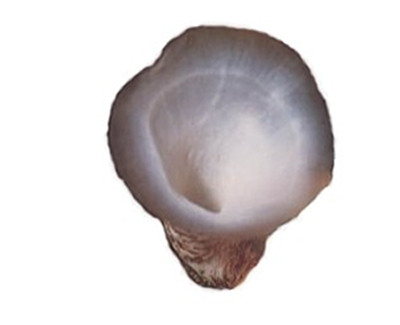
Until now - whenever Steve Dean saw small anemones and feathery worms sticking out of cracks between rocks in rock pools and on reefs he
gently stuck his finger in them to see their reaction. Once he became aware of what this photo was of, he lost all interest in continuing with this practice.
Can you guess what this photo is?
(See this issue)
Turbinellidae Part 17
Urlich Knodel
This part deals with two rather closely related species from the Indopacific. It is assumed that they are derived, together with
Vasum rhinoceros, from the extinct species V. aqitanicum from the lower Miocene. Another group (i.e. V. armatum and V. ceramicum) seems also to be closely related although fossil specimens are poorly known till now. The species discussed here have a typical 'vasiform' shape, a good size and they are common: this makes them well known to collectors.
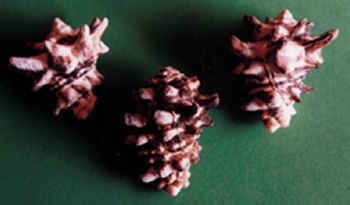
Vasum turbinellus (Linnaeus, 1758)
As Murex turbinellus Linnaeus, 1758
syn. Volutella nigra Perry, 1811
syn. Turbinella variolaris Lamarck, 1822 (it being based on a juvenile but worn specimen)
syn. Turbinella cornigera Lamarck, 1822 ( which is the doubtful "forma cornigerum").
The "Common Pacific Vase Shell" is (name!) one of the most common Vase shells of the Pacific. It ranges from East Africa throughout the Indopacific to western Polynesia. Often it is common, in some regions, even abundant. It is a heavy solid, strongly spined species; the shell is coloured black and white. The usual size is 50 to 80 mms.
The species lives in a range from the intertidal zone to a depth of roundabout 3 metres. It inhabits in some areas reef flats, hidden during the day under coral rocks and boulders. In other regions it lives in sand, coral rubble and eelgrass.
Forma cornigerum (Lamarck, 1822)
This form has extra long spines. It is reported to be most common off the Philippines. A 60mm large typical form has spines that are of the order of 6 - 9mms long (the largest spines being on the shoulder). A shell of f. cornigerum of the same size has spines which are of the order of 15 - 18 mms in length. The spines f. cornigerum are much more slender. I have found among 18 specimens examined of f. cornigerum that 17 of them had one less spine per whorl on the shoulder as the typical form exhibits.
The development of longer spines is in most species an indicator for habitat in very quiet water and softer substrates; shells from rough water environments tend to have shorter spines. However in f.cornigerum the whole shell looks somewhat different to the typical form.
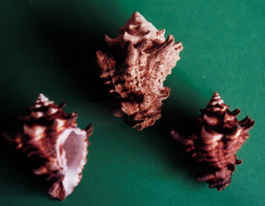
Vasum tubiferum (Anton, 1839)
as Turbinellus tubifera Anton, 1839
syn. Turbinellus imperialis Reeve, 1842
The "Imperial Vase Shell" seems to be restricted to the waters of the Philippines; most records are from the central western region there. The Cujo Islands are the 'locus typicus'. The shells in my collection are except for one, all from Cujo, collected by the late R. Tucker- Abbott in July 1958 during the Du Pont Academy expedition. One specimen I have from a collector on Culion Island. Most of the shells from other collections I have examined had only locality data as "western Philippines" or only "Philippines". Untill
now I have not heard of specimens from other localities outside the Philippines. Neither Anton nor Reeve gave precise locality data. Reeve stated that the described specimens were collected 'probably at Mindanao, Philippines'.
This beautiful species (real gems exist!) is reported from very shallow water in quiet bays. It lives on sand and eelgrass bottom. The size of the shell is usually 60 - 80 mms; up to 120 mms has been recorded. The shell looks somewhat like Vasum turbinellus, but is much more elegant. The body whorl has four rows of knobs but the knobs are only rounded or with very short spines; not as strongly knobbed and spined a V. turbinellus. V. tuberifum also differs in having a deep and pronounced umbilicus. The coloration is brown and white; often parts are very dark brown but never black as in V. turbinellus. The shoulder spines are somewhat more slender than in V. turbinellus and usually one less per whorl. This species seems to be a separate regional development of the V. aquitanicum lineage.
Pet Conus
Tassie, in Cairns always has unusual pets in his small fish tanks. Recently he had a
Conus geographus, a carnivorous species known to have killed humans.
When his cone is hungry it quickly moves around the tank looking for small fish. As the photos show it does not wait until it harpoons prey to extend its mouth. It parades itself with mouthparts fully extended, and as the photo on the front cover shows it has the mouth fully open as well.
I have removed the other parts of the pictures for clarity. In the picture on the right, the cone is moving across rocks in the tank.
In the photo on the front page the cone is completely out of site behind rocks with the mouthparts coming around the rock, showing only as a large open tube, with no evidence of what is lurking behind. It looks very tempting for humans to touch, or for small fish to nip.
These excellent action shots are courtesy of Barbara Collins.
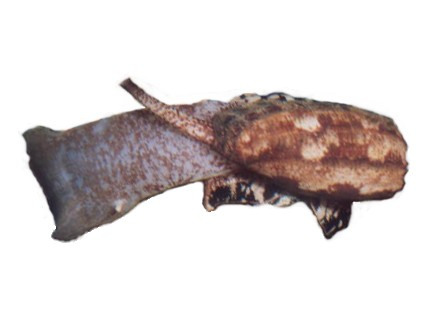
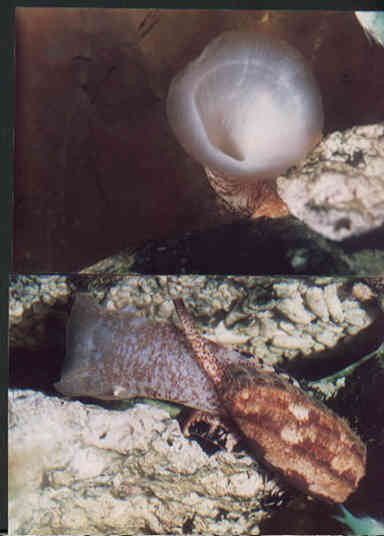
Shell Club Minutes
January (previously missed)
The meeting was opened by Maureen Anderson at 2.00 pm.
Field Trip Reports M. Keats & S. Clark reported on a trip to Jervis Bay, to the "type locality" (Target Bay, torpedo firing range?) in search of Meridolum sp., a snail that lives in the littoral rainforest habitat. Specimens were found, though wet weather would have aided the investigation.
K. & S. Dean reported on a visit to Long Reef just to see how
healthy it was, though nothing of interest was observed.
New Acquisitions C. Barnes reported collecting a number of Smaragdia souverbiana (Gassies, 1861) live while straining sea grass with Des Beechey on New Years Day.
M. Keats visited Yarra Bay and collected three specimens of Trigonostoma vinnulum
Iredale, 1925.
A. Miskelly collected a specimen of Cymbiola magnifica (Gebauer 1802) from Botany Bay.
New Books D. Beecheys' web site, "The Seashells of New South Wales" at http://members.optushome.com.au/desbee/ covers a number of families and depicts many rare and unusual specimens. The site is a work in progress and Des is still working through the families and updating when time allows.
General Business
Chris Ann Urquhart has sent an email letter requesting the number of active members in the Sydney sub branch so that MSA National can reimburse fees.
An email letter was sent to Des Beechey requesting that a new level of Non Professional membership be established.
A letter was sent to Chris McCarthy of Ryde Eastwood Leagues Club requesting a listing of the Sydney Shell Collectors Club Inc in their Community Service Information page.
Michael Keats reported that Kay Rutland is moving into a retirement village at Woolwich. She has kindly donated items to the club for Michael to auction. There will be 3 lots; including corals jigsaw puzzles, volutes and shell art items.
Auction: The auction realised $122.00
Other items will be used as raffle prizes at future meetings.
Meeting closed at 2.30pm
C. & K. Barnes
Secretary
Shell Club Minutes
July 2002
The meeting was opened by Patty Jansen at 2.04 pm.
Visitors: Peter Honkoop and Rob West.
Field Trip Reports
M. Keats reported on a visit to Norfolk Island two weeks ago. Being adventurous, Michael was able to organise a one day tour of Phillip Island, which was almost denuded when left as a game reserve, with introduced feral animals (goats, pigs, rabbits) by early settlers. Michael described the amazing ground colours as pink, gold and grey to name a few, this was due to the topsoil being washed away.
Michael managed to find six specimens of a land snail that will be sent off for identification.
R. Moylan reported on his recent visit to the Keppel Bay shell show, Ron noted that attendance was down from previous years yet exhibits were lovely and the quality of material very high. Ron added that it was the 40th birthday of the club and the 35th shell show.
P. Jansen reported on a visit to Chinaman's Beach where many micro shells were found.
C. Barnes handed around a number of specimens from Long and Little Bays, these included Hydatina amplustre, Linnaeus 1758, Haliotis brazieri Angus, 1869 and Haliotis hargravesi Cox, 1869.
General Business
Treasurer:- J. Franklin reported that the branch's current operational balance was $2013.13
John also reported on a quote from RELC, $5000 for the rooms for a weekend, plus staff and extras, would bring the total to $6,000 to host an event such as a Sydney National Shell Show.
Letter:- Rob West Re- attending today's meeting possibly with some New Guinea shells for sale.
Discussion about venue for next Sydney NSS, also fund raising possibilities.
J. Franklin:- discussion about guest speakers and costing for upcoming annual shell show.
Presentation
Today, presentations are on favourite shells from various group members.
Patty brought in her collection of Tellin shells from all over the world.
Ashley brought along a specimen of Livonia roadnightae (McCoy, 1881).
Michael displayed a very large specimen of Conus vexillum Gmelin, 1791 obtained near the Isle of Pines, New Caledonia. Michael explained how he had come by the shell and transported it back to Sydney in Jenny's luggage
R. Moylan presented an awesome display of fine pieces including multiple, Cypraea broderipii (Sowerby 1832), C. leucodon (Broderip 1828), C. marginata ketyana bataviensis Lorenz & Morrison 2001 and two very fine C. cribraria exmouthensis (Melvill 1888). Ron also displayed a world record sized Cymbiola perplicata (Hedley, 1902) plus one unusual colour form. A number of beautiful cones and a very rare colour form of Harpa major Röding, 1798 were also part of Ron's incredible favourites.
J. Franklin displayed a sinistral specimen of the family Buccinidae.
Meeting closed at 3.10 pm
C. & K. Barnes
Secretary
NEW ZONING PLAN OF JERVIS BAY N.S.W.
- 1st October 2002
John Franklin
New South Wales Marine Parks Authority have published an overview of the zoning plan for the Jervis Bay Marine Park. The zoning plan commences on 1st October 2002. For malacologists, conchologists and the general shell collecting public, introduction of the zoning plan will place restrictions on both research and collecting activities.
Jervis Bay Marine Park is approximately 180km south of Sydney and 20km south east of Nowra, in the Batemans marine bioregion. The marine park covers an area of approximately 22,000 hectares and spans over 100km of coastline and adjacent ocean, extending from Kinghorn Point in the north to Sussex Inlet in the south and including most of Jervis Bay.
The objectives of the Marine Parks Act 1997, are:
- to conserve marine biological diversity and marine habitats by declaring and providing for the management of a comprehensive system of marine parks,
- to maintain ecological processes in marine parks,
and where consistent with the preceding objectives:
- to provide for ecologically sustainable use of fish (including commercial and recreational fishing) and marine vegetation in marine parks, and
- to provide opportunities for public appreciation, understanding and enjoyment of marine parks.
Under the zoning plan the Jervis Bay area has been divided into sanctuary zones, habital protection zones, special purpose zones and general use zones. At one end of the scale sanctuary zones provide areas representative of the highest in biological diversity whilst at the other end general use zones provide a level of environmental protection, at the same time, providing a wider range of commercial and recreational activities.
After the first of October 2002, permission / a permit must be obtained for the purposes of scientific / educational collection. Whilst the above information is based on a document entitled "Overview of the Zoning Plan" Jervis Bay Marine Park, June 2002, it is intended that further information will become available to the public prior to that date.
Activities permitted in protective zoning
Table 1. Summary
of activities permitted in each zone
|
Activity
|
Sanctuary
|
Habitat Protection
|
General Use
|
|
Collecting
|
|
|
|
|
Collecting (scientific/educational)
|
P
|
P
|
P
|
|
Collecting (recreational: bait, shellfish etc.)*
|
x
|
[(e)
|
[
|
“P”
Permission required from Marine Parks Authority
(e)
Restrictions apply to the species that can be
collected (see Species List in Table 5 and additional information below.
Table 5.
Species that may be taken from habitat protection zones*
|
Common
name
|
Class/Family
|
Species
|
|
Abalone
|
Family
Haliotidae
|
All
species
|
|
Turban
shell
|
Family
Turbinadae
|
All
species
|
|
Pipi
|
Family
Donacidae
|
Donax
deltoides
|
|
Commercial
scallop
|
Family
Pectinidae
|
Pecten
fumatus
|
|
Doughboy
scallop
|
|
Chlamys
asperrimus
|
|
Blue
mussel
|
Family
Mytilidae
|
Mytilus
planulatus
|
|
Sydney
cockle
|
Family
Arcidae
|
Anadara
trapezia
|
|
Mud
oyster
|
Family
Ostreidae
|
Ostrea
angasi
|
|
Sea
urchin
|
Class
Echinoidea
|
Centrostephanus
rodgersii
Heliocidaris erythrogramma
|
*(unless otherwise restricted under the Fisheries Management Act or protected under other specific legislation).
Note: NSW Fisheries bag and size limits apply.
Regulation of specific activities - Collecting
Collection of marine plants and animals within the Jervis Bay Marine Park is subject to the following:
- collecting plants, animals and fossils for educational or scientific purposes may be allowed, however a permit is required
- collecting shells and shell grit is allowed in habitat protection and general use zones for non-commercial purposes.
Members are advised to contact the Park authorities in order to ascertain the zoning applicable to the proposed research area, whether a permit is required and to obtain more information. Contact The Jervis Bay Marine Park, Dent Street, Huskisson NSW 2540, www.mpa.nsw.gov.au - phone (02) 4441 7752.
ANNUAL SHELL SHOW 2002
PROGRAM
Date: Saturday 26th October 2002
At: Ryde Eastwood Leagues Club
"Ryedale Room"
117 Ryedale Road, West Ryde
11.00 a.m. - 1.30 p.m. Set up exhibits
12.30 p.m. Luncheon - own arrangements
1.30 p.m. - 2.00 p.m. Judging
2.00 p.m. Exhibition Open
2.30 p.m. Mr. Ian Loch - Guest Speaker
4.00 p.m. Close
Refreshments will be served throughout the afternoon.
Turbinellidae Part 21
Ulrich Knodel
The first two sub families displayed here in this series had an acknowledged placement close together since the beginning of malacology. The often rather large, beautiful and mostly common shells were handled by malacologists for a long time with several studies available. The following third sub family is still a kind of "white blotch" within the family with a lot of misunderstandings in common literature.
Ptychatractinae Stimson 1865
The whole group seems, until now, to be rather poorly understood. It contains a "mixture" of species and genera often from the Volutes and Volutomitridae. New placements of single species has created some confusion.
In 1981 Quinn proposed the new genus Cyomesus in Ptychatractinae and herein
C. barthelowi (Bartsch, 1942), which was originally published as Prodallia b. and later placed by
Weaver & duPont in 1970 as Teramachia b. in Volutidae (Calliotectinae). Quinn only proposed this species in Cyomesus but soon authors used Teramachia as a synonym of Cyomesus or placed Teramachia as a valid genus in Ptychatractinae (see Abbott in "American Seashells" for example).
Another puzzle is "Mesorhytis meekiana". The genus Mesorhytis was proposed by
Meek in 1876 for a fossil species (Mesorhytis gracilenta Meek, 1876). Some years later in 1889,
Dall published Fasciolaria (Mesorhytis) meekiana, a recent species. Dall had seen Mesorhytis as a subgenus of Fasciolaris. In later studies this species was called Teramachia m. by Bayer (1971) and
Benthovoluta m. by Cernohorsky (1973). But it was said turbinellid and not fasciolariid; Quinn (1981) designated this species as type species for his new genus Cyomesus. None of the authors placed the whole genus
Termachia Kuroda, 1931 in Turbinellidae; the genus is still seen today in Volutidae, either as a genus closely related to Calliotectum Dall 1890 or following Bondarev 1997- as a synonym of it. The "real" Mesorhytis is until now listed as a fossil genus in Volutomitridae (Vaught 1989) but Quinn said it was closely related to this Cyomesus and perhaps the precursor of this turbinellid group.
The acknowledged real Ptychatractinae are the genera Ptychatractus, iestochilus (sub genus) and Metzgeria; too Ceratoxancus (fide Cernohorsky, 1973). Surculina (syn Phenacoptygma; see Götting, 1974) was placed in Volutidae; one species ("P. kiiensis Kuroda 1931) was later separated as new genus Benthovoluta. Rehder, 1967, placed the group together in Ptychatractinae. The genus Latiromitra was seen near Volutomitra (Volutomitridae) and later a sub genus of it. It was placed there because of its mitrid shell shape but the volutid radula.Before Ponder (1973) reduced the old super families Buccinoidea, Nassaoidea and Volutoidea to a family status in the Muricoidea, the relationshipof the turbinellid group was easy to see: Turbinellidae, Volutomitridae (with Latiromitra) and Volutidae ( with Suculina, Termahia et al) were all seen close together a superfamily Volutoidea (= Volutacea).Today, listed in alphabetical order in the giant Muricoidea, this relationship is not clearly seen but it is a fact. New higher systematics see Lindner, 1999 (5th edition) and in Ponder & Waren, 1998.
"Ptychatractinae today " in general one can say are slender, high spired fusiform shells with a long narrow aperture and weak columellar folds; the anatomy is turbinellid. They live in deep water (bathyal and abyssal), mostly in warmer Pacific and western Atlantic Ocean.
Most of the shells are small, not larger than 35-40mm; most are less than 20mm. The usual colouration is, due to the deep water habitat, whitish, greyish or brownish without bright colouration. They are hard to get: most species were dredged during scientific deep sea expeditions and the shells are stored in museums. This all makes Ptychatractinae not just "Top Hits" for private shell collections. One should be even more careful when purchasing them: a lot of very juvenile abundant buccinids and others look rather similar to
Ptychatractinae.
Comparing the shells of this sub family (best on enlarged photos) one can easily recognise three groups.
1st the Ptychatractus group:
the shells are somewhat more swollen, the canal somewhat shorter. Prominent spiral cords cover the whole of the outer shell
(Ptychatractus ligatus, Cyomesus aratiunculus )
2nd the "Metzgeria group":
swollen as above or more slender but the spiral cords are crossed by axial ribs which gives this shell a knobby appearance
(Metzgeria californica, Cyomesus costatus).
3rd the "Teramachia group":
slender with a longer canal; the body whorl is more or less smooth with strong axial ribs only on the early whorls
("Teramachia" barthlowi, "Mesorhytis" mekiana)
The three names above are nomen nudum and not relevant. I do not propose to name "groups", nor should these names be cited in further studies but the three kinds of shell shapes are constant and obvious. The original description of genus Cyomesus Quinn, 1981 (cit .:….Sculpture on early whorls of strong axial ribs, usually becoming obsolete on later whorls ; spiral sculpture present or absent.") makes it difficult for me to acknowledge "shell sculpture" in this genus:
Cyomesus aratiunculus Quinn, 1981 looks to me as if it belongs to the group
"Ptychatractus" (compare fig. 4, pl.1, Natilus vol.95(2)). I will neither propose a change nor will I question the placement in this study but will display the "white blotch": the group surely needs further
studies.
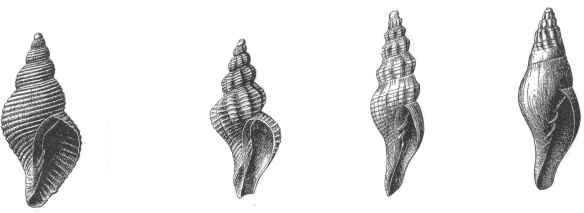
From Left to Right:
"Ptychatractus group": Ptychatractus occidentalis Stearns, 1873
"Metzgeria group": Metzgeria californica Dall, 1903
"intergrade": Mesorhytis costatus Dall, 1980 (more slender, body whorl already somewhat smooth)
Teramachia group": Cyomesus meekianus Dall, 1889
(Copied without permission from "American Seashells")
The systematical arrangement below follows Vaught (1989), modified by me (partim) and enlarged (fide Quinn, 1981):
Muricodea
Rafinesque, 1815
Turbinellidae
Swainson, 1840
3. Ptychatractinae Stimson, 1865
Ptychatractus ligatus (Mighels & Adams 1842) type species
Ptychatractus
Stimson, 1885
(Piestochilus)
Meek, 1864
Benthovoluta
Kuroda & Habe 1950
Ceratoxancus
Kuroda, 1952
Cyomesus
Quinn, 1981
Syn: Mesorhytis
in Dall, 1889 (non Meek, 1876)
Syn: Prodallia
Bartsch, 1942 (partim)
Syn: Teramachia
in Weaver & duPont, 1970 (partim)
(non Kuroda, 1931)
Latiromitra Locard, 1897
Syn: Latriomitra
Ponder, 1968 (nom. null.)
Metzgeria
Norman, 1879
Pro Meyeria
Dunker & Metzger, 1878
(non McCoy, 1849)
Surculina Dall, 1908
Syn: Phenacoptygma
Dall, 1908
Syn: ? Chatchamidea
Dell, 1956 (?)
Fusimitra (fossil)
Conrad, 1855
Uncertain
? Palaeofusimitra
Sohl, 1963 (fide Quinn, 1981)
? Mitridomus
Sohl 1963 (fide Quinn, 1981)
? Mesorhytis
Meek, 1876 (may be placed here according to Quinn, 1981)
References (selected):
Abbott,R.T., 1974 "American Seashells", 2nd ed. Van Nostrand
Bayer,F.M., 1971 "New and Unusual Molluscs: Tropical West Atlantic" Bull. Mar. Sci. 21(1): 111-236
Cernohorsky, W.O., 1973 "Syst. Mitridae and Volutomitridae" Bull.Auckl.Inst.Mus. 8: 1-190
Götting, K.J. 1974 "Malakozoologie" G. Fischer Verlag; FRG
Lindner, G., 1999 "Muscheln und Schnecken der Weltmeere" 5th rev. ed., BLV Verlag, FRG
Ponder, W.F., & Waren,A., 1988 "Classification: Caenogastropoda and Heterostropha"' Malac. Review, Suppl.4:228-326.
Quinn, J.F. 1981 "A New Genus of Turbinellidae: Caribbean". Nautilus 95(2): 72-77.
Vaught, K.C. 1989 "A Classification of the Living Mollusca", American Malacologists, Fla.
Weaver, C.S. & duPont, J.E., 1979 "The Living Volutes" Del.Mus.Nat.Hist., XV +375 pp
Shell Club Minutes
24/8/02
The meeting was opened by Patty Jansen at 2.02 pm.
Field Trip Reports
C. Barnes reported on a visit to Long Bay, finding a large broken Cypraea subviridis Reeve, 1835 and a small C. vitellus
Linnaeus 1758 measuring 31mm. Cronia margariticola (Broderip, 1833) was also collected.
General Business
P. Jansen informed the meeting that in the next edition of Australasian Shell News she has announced Sydney is interested
in hosting the 2006 National Shell Show. Discussion about the 2006 NSS followed.
Carmen A. Guisande has resigned as a member. Merv Cooper from Western Australia is a new member.
The Club where we meet has again donated a ninety dollar dinner voucher to be raffled at the annual show.
Presentation
Ron Moylan gave a talk on Cypraea mappa Linnaeus, 1758. Ron had a comprehensive display of the various sub species
and forms, showing the amazing colour range, for the group to view (some quite rare). Geographical distribution and habitat were also discussed. Ron also brought along an ultra violet (black light) lamp, as a number of authors have reported fluorescence being observed with certain shells. While the lights were dimmed a spectacular red/rose/pink glow was given off by most of the C. mappa shells under the "black light".
P. Jansen offered a vote of thanks from the group for Ron's efforts.
Meeting closed at 3.15 pm
C. & K. Barnes
Secretary
|






